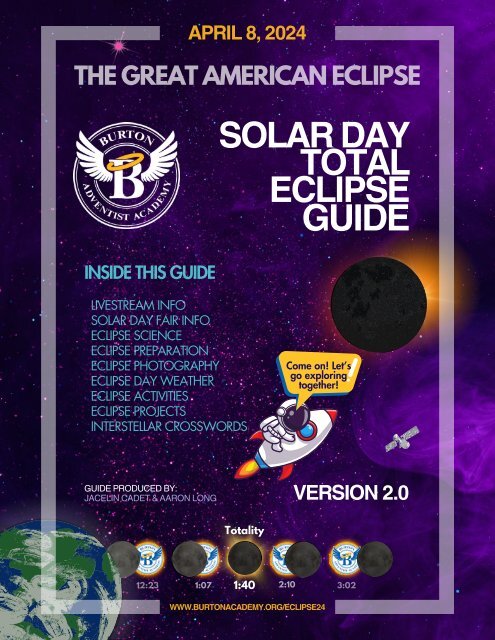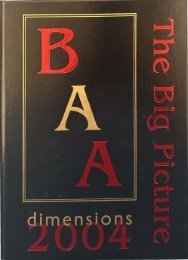BAA Solar Day Guide Version 2.0
You also want an ePaper? Increase the reach of your titles
YUMPU automatically turns print PDFs into web optimized ePapers that Google loves.
APRIL 8, 2024<br />
THE GREAT AMERICAN ECLIPSE<br />
SOLAR DAY<br />
TOTAL<br />
ECLIPSE<br />
GUIDE<br />
INSIDE THIS GUIDE<br />
LIVESTREAM INFO<br />
SOLAR DAY FAIR INFO<br />
ECLIPSE SCIENCE<br />
ECLIPSE PREPARATION<br />
ECLIPSE PHOTOGRAPHY<br />
ECLIPSE DAY WEATHER<br />
ECLIPSE ACTIVITIES<br />
ECLIPSE PROJECTS<br />
INTERSTELLAR CROSSWORDS<br />
Come on! Let’s<br />
go exploring<br />
together!<br />
GUIDE PRODUCED BY:<br />
JACELIN CADET & AARON LONG VERSION <strong>2.0</strong><br />
Totality<br />
1:40<br />
12:23 1:07<br />
2:10 3:02<br />
WWW.BURTONACADEMY.ORG/ECLIPSE24
TABLE OF CONTENTS<br />
Livestream Info ................................................................<br />
<strong>Solar</strong> <strong>Day</strong> Fair Info ..........................................................<br />
Eclipse Overview ............................................................<br />
Eclipse Science ...............................................................<br />
Eclipse Preparation ..........................................................<br />
Eclipse Photography ........................................................<br />
Eclipse Weather .............................................................<br />
Eclipse Crosswords .........................................................<br />
Glossary of Terms ...........................................................<br />
2<br />
5<br />
6<br />
8<br />
10<br />
11<br />
12<br />
15<br />
19<br />
Why a Special <strong>Guide</strong>?<br />
We can celebrate our belief in God as<br />
Creator and our belief in the beautiful world of<br />
Science too! In fact, God is a God of order!<br />
So, through your study of the Bible and the<br />
incredible universe God has created for us to<br />
enjoy and marvel at, it is our sincere prayer<br />
that you will have a deeper appreciation for<br />
science while reinforcing your belief in God<br />
and His creative power as expressed<br />
throughout nature and the Bible, including the<br />
creation story!<br />
God sure is amazing<br />
to create all of this<br />
for us to enjoy!<br />
“In the beginning, God<br />
created the heavens and<br />
the earth. The earth was<br />
without form, and void;<br />
and darkness was on<br />
the face of the deep.”<br />
Genesis 1:1,2<br />
This free solar eclipse guide is offered for educational purposes, and may be printed and redistributed free of charge<br />
without further permission. This guide may not be sold, and may not be modified without permission. A special thanks<br />
to SWAU, Michael Zeiler and www.GreatAmericanEclipse.com, Jay Anderson and www.eclipsophile.com, as well<br />
our livestream guests for sharing content for this guide.<br />
T<br />
S<br />
TALLY<br />
LARIFIC<br />
APRIL 8, 2024<br />
1
LIVESTREAM INFO<br />
Don’t miss our exclusive total solar eclipse “pre-game” show featuring entertaining<br />
hosts, a stellar list of scientific guests, weather highlights, interactive games & topnotch<br />
content, all geared towards enhancing your eclipse-viewing experience!<br />
You’ll have the opportunity to share your eclipse knowledge and compete to win<br />
prizes in our interactive game taking place around 12:45 pm CT! To prepare,<br />
you’ll want to study this guide and tune in to all the livestream action!<br />
Livestream Details<br />
Sunday Livestream Preview: 6:00 pm CT<br />
Monday Livestream Kickoff: 11:30 am CT<br />
Where to Stream:<br />
www.burtonacademy.org/eclipse24<br />
Facebook Livestream Event Page<br />
Youtube<br />
Livestream Wrap-up: 2:00 pm CT<br />
Did you know?<br />
The next total solar eclipse visible<br />
in the contiguous United States<br />
will take place in 2044 but will<br />
only be visible in North Dakota<br />
and Montana. (NASA.com)<br />
Livestream Hosts<br />
Adrian Mizher<br />
A Burton parent and CTA<br />
Alumni (class of 97), Adrian<br />
returns after hosting our<br />
spelling bee livestream event to<br />
anchor the solar day livestream<br />
sharing his enthusiasm and wit<br />
as he fills the role of our playby-play<br />
host.<br />
Reggie Herman<br />
As a Burton Alumni (class of<br />
95), Reggie brings an<br />
enthusiastic love and<br />
knowledge of weather along<br />
with his livestream hosting<br />
experience which is sure to<br />
entertain as he fills out the role<br />
of color commentator.<br />
T<br />
S<br />
TALLY<br />
LARIFIC<br />
APRIL 8, 2024<br />
I can’t wait for<br />
all the fun on<br />
the livestream!<br />
2<br />
Bradley Colvin<br />
As a Burton Alumni (class of<br />
09), and <strong>BAA</strong> HS English &<br />
History Teacher, Mr. Colvin<br />
returns after co-hosting our<br />
spelling bee livestream event to<br />
share his relatable and uplifting<br />
spirit as our remote interview<br />
host bringing all the fair action<br />
and guest on-site interviews to<br />
life!
LIVESTREAM INFO<br />
Dr. Jake Hebert<br />
Livestream Guests<br />
Dr. Hebert received his Ph.D. in<br />
Physics from UT Dallas in 2011<br />
where he did cutting edge research<br />
on the connection between cosmic<br />
rays, solar activity, and weather<br />
and climate, joining the ICR team<br />
where he serves as a Research<br />
Scientist focusing on cosmology<br />
among other topics.<br />
Emily Steele<br />
Emily serves as the Children’s<br />
Education Specialist for the<br />
Institute for Creation Research<br />
and brings her heart for<br />
education and support for<br />
Christian science education to the<br />
livestream as she emphasizes the<br />
God behind the eclipse, our<br />
Creator!<br />
Dr. Tim Standish<br />
I’m dreaming<br />
about how cool<br />
the livestream<br />
will be!<br />
Dr. Standish, a Seventh-day<br />
Adventist, received his Ph.D. in<br />
Environmental Biology and Public<br />
Policy from George Mason<br />
University and is the Senior Scientist<br />
at the Geoscience Research<br />
Institute. Dr. Standish is also a<br />
widely published author, speaker,<br />
and producer.<br />
Special Guests:<br />
Physicist<br />
Telescope Inventor<br />
Senior Scientist<br />
Jim Burr<br />
Livestream Highlights<br />
Interactive Game<br />
On-screen Livechat<br />
Share Your Photos<br />
Weather Updates<br />
Jim Burr, a Seventh-day Adventist,<br />
owned and operated JMI, a worldrenowned<br />
telescope manufacturing<br />
company. Among other notable<br />
successes, Jim built telescopes for<br />
NASA and invented the binocular<br />
telescope, and now runs the<br />
creation science ministry<br />
organization Heavens Declare.<br />
Eclipse Tracker<br />
Eclipse Fair Action Cam<br />
Eclipse Science<br />
And More!!<br />
Did you know?<br />
The next total solar eclipse that will span<br />
the contiguous 48 states won’t happen<br />
until 2045. (NASA.com)<br />
Connect and Interact!<br />
We are excited to offer an interactive<br />
livestream experience where you can<br />
submit your group, family, or school photos<br />
from eclipse day and we’ll share them on<br />
air! Submit photos to<br />
solarday24@burtonacademy.org. So get<br />
ready to be a part of the livestream!<br />
T<br />
S<br />
TALLY<br />
LARIFIC<br />
APRIL 8, 2024<br />
3
LIVESTREAM INFO<br />
Interactive Livestream Game Info<br />
How can I prepare for the game? The best<br />
way to prepare is to study this guide, and<br />
tune in to the livestream! All of the questions<br />
will come from this guide! In fact, we will<br />
have 10 questions that will determine the<br />
winner! And, the top 3 participants win a<br />
prize pack to commemorate the day! And of<br />
course, make sure you know how to join a<br />
Kahoot game before we kick off!<br />
What’s needed to participate? All you’ll<br />
need is a device with access to the Kahoot<br />
website or app and internet access of<br />
course.<br />
When will the game take place? At<br />
approximately 1 pm Central Time.<br />
How long will the game last? About 10<br />
minutes.<br />
How many people can play? The first 400<br />
people can join the game!<br />
Prizes!!<br />
To the winner go the spoils! We’ll send the<br />
top three participants a special pack of<br />
<strong>Solar</strong> <strong>Day</strong> swag! Just email a screeshot of<br />
your final game status to<br />
solarday24@burtonacademy.org!<br />
I’m gonna<br />
study this guide<br />
front to back!<br />
T<br />
S<br />
TALLY<br />
LARIFIC<br />
APRIL 8, 2024<br />
T<br />
S<br />
TALLY<br />
LARIFIC<br />
APRIL 8, 2024<br />
Did you know?<br />
A totally eclipsed Sun is about as bright<br />
as a full Moon, which is about 400,000<br />
times less bright than a non-eclipsed Sun.<br />
T<br />
S<br />
TALLY<br />
LARIFIC<br />
APRIL 8, 2024<br />
4
SOLAR DAY FAIR INFO<br />
If you haven’t yet made your solar day viewing plans, you won’t want to miss the best<br />
party in town! As a celebration of the events of the day, Burton Academy is hosting a<br />
FREE <strong>Solar</strong> <strong>Day</strong> Fair featuring fair foods, education, games, fun (bounce houses and<br />
dunking booth) and interactive experiences! All guests will also receive a complimentary<br />
pair of limited edition Burton Academy solar viewing glasses. Space is limited so don’t<br />
delay in securing your tickets today! Fair goers are encouraged to bring lawn chairs to set<br />
up on Perryman Field (our group viewing area), and then purchase tickets for food and<br />
activities to enjoy as we watch the solar eclipse head towards totality at 1:40 pm local<br />
time! Don’t want to miss the livestream? Don’t worry. You’ll get to enjoy and interact from<br />
designated viewing areas on campus.<br />
GET FREE TICKETS NOW<br />
Woohoo!<br />
Party time!<br />
FAIR HIGHLIGHTS<br />
Tickets Required<br />
A Whole Family Event<br />
Food, Education, Games, Fun!<br />
Bounce Houses<br />
<strong>Solar</strong> Telescopes & Viewers<br />
<strong>Solar</strong> Viewing Glasses<br />
Event Time: 10:30 am - 2:00 pm<br />
Event Info: While tickets are free, we encourage<br />
guests to bring money to exchange for fair tickets to<br />
enjoy games, food, and activities!<br />
Check-in Process: Guests will be required to show<br />
their EventBrite ticket QR code and will receive<br />
event wrist bands verifying their ticketing status.<br />
Did you know?<br />
The Antikythera mechanism, built over<br />
2,000 years ago and discovered in a<br />
Greek shipwreck, could predict eclipses.<br />
4611 Kelly Elliott Rd.<br />
Arlington, TX 76017<br />
www.BurtonAcademy.org/eclipse24<br />
T<br />
S<br />
TALLY<br />
LARIFIC<br />
APRIL 8, 2024<br />
5
ECLIPSE OVERVIEW<br />
Who will be able to see the eclipse and where will it be visible? In fact, the entire<br />
contiguous US will be able to see the eclipse on April 8, but only people inside the<br />
narrow band outlined in yellow on the map below will be able to experience<br />
totality, where day turns to night!<br />
Let’s track the<br />
eclipse<br />
together!<br />
MAP SHOWING THE 25 MOST POPULOUS CITIES IN THE PATH OF TOTALITY FOR THE APRIL 8, 2024 ECLIPSE, WITH THEIR<br />
ESTIMATED POPULATIONS. CREDIT TO MICHAEL ZEILER, GREATAMERICANECLIPSE.COM.<br />
T<br />
S<br />
How many total people live in the<br />
path of totality? As you might have<br />
guessed, it’s a whole lot of people!<br />
In fact, it’s estimated that nearly<br />
32,000,000 people live in the path<br />
of totality!<br />
TALLY<br />
LARIFIC<br />
APRIL 8, 2024<br />
6<br />
Did you know?<br />
The last total solar eclipse in the DFW area<br />
happened on July 29, 1878! That will make it<br />
146 years between total solar eclipses for DFW,<br />
way less than the average! (NASA.com)
ECLIPSE OVERVIEW<br />
When will we get to experience totality and for how long? It’s really incredible how<br />
quickly the eclipse moves across the landscape! In fact, from the time the eclipse<br />
enters Texas, it will span the entirety of the contiguous 48 states in just over 1 hour!<br />
In Arlington, TX we will experience totality for 3 minutes and 23 seconds.<br />
Don’t get caught<br />
snoozing when<br />
it’s your turn to<br />
see the eclipse!<br />
MAP SHOWING THE APPROXIMATE TIMES WHEN TOTALITY WILL BE EXPERIENCED ACROSS THE UNITED STATES.<br />
CREDIT TO MICHAEL ZEILER, GREATAMERICANECLIPSE.COM.<br />
T<br />
S<br />
Did you know?<br />
The path of the 2024 eclipse will<br />
cross over four state capitals.<br />
TALLY<br />
LARIFIC<br />
APRIL 8, 2024<br />
Be ready or you’ll be sorry! While the map<br />
above indicates an approximate viewing<br />
time of 1:35 pm in the DFW metroplex, we<br />
will begin to experience totallity at 1:40 pm.<br />
So, let’s go with the 1:35 pm time so we are<br />
sure not to miss out!<br />
7
ECLIPSE SCIENCE<br />
What is a total solar eclipse? A total<br />
solar eclipse occurs when the Moon<br />
passes between the Sun and Earth,<br />
fully blocking the Sun's light and<br />
creating temporary darkness on Earth.<br />
This happens when the Sun, Moon,<br />
and Earth are in a direct line. The sky<br />
becomes very dark, similar to<br />
nighttime, and the Sun's outer<br />
atmosphere, corona, becomes visible.<br />
Did you know?<br />
Compared to the 2017 eclipse, the<br />
2024 eclipse has a duration of<br />
totality that's about 68 percent<br />
longer and a path of totality that's<br />
about 76 percent wider at its widest<br />
point.<br />
Try out NASA’s interactive eclipse<br />
simulator here!<br />
Importance and rarity. A total solar eclipse is<br />
an infrequent occurrence, making it an<br />
exciting and highly anticipated event for those<br />
who can see it. While there will be other total<br />
eclipses in other parts of the world and North<br />
America, the DFW area will not experience<br />
another total eclipse for more than 175 years.<br />
This is truly a once-in-a-lifetime event!<br />
What makes this eclipse so special<br />
and exciting? Not only will this<br />
eclipse be visible for a whole lot of<br />
people, but it is also visile for longer<br />
than many! There are numerous<br />
factors that can impact the length of a<br />
total solar eclipse, but primarily it is<br />
the distance the moon is from the<br />
earth that impacts the length the most.<br />
In fact, the April 8 total solar eclipse<br />
will offer nearly twice as long of a<br />
viewing opportunity as the last one in<br />
2017!<br />
What will the eclipse look like<br />
from Burton’s campus? To get<br />
an idea, try out the eclipse<br />
simulator built by<br />
eclipse2024.org!<br />
So much to learn<br />
about eclipses!<br />
Let’s study<br />
together!<br />
T<br />
S<br />
TALLY<br />
LARIFIC<br />
APRIL 8, 2024<br />
8
ECLIPSE SCIENCE<br />
What’s the difference between a partial, annular, and total solar eclipse? That's a<br />
great question we’d love to dive into! A partial solar eclipse happens when the<br />
Moon, Sun, and Earth aren't in perfect syzygy (alignment). The Moon's disk covers<br />
only a portion of the Sun as seen from Earth. Observers within the path of the Moon's<br />
shadow fall into the penumbra - an area of partial sunlight blockage. Only a<br />
percentage of the Sun's light is obscured.<br />
An annular solar eclipse takes place when the Earth, Moon and Sun are in perfect<br />
alignment, but at a point where the Moon is further away from the Earth causing the<br />
Moon’s disk to not be able to block the entirety of the Sun’s light resulting in the<br />
famous “ring of fire” experience!<br />
T<br />
S<br />
A total solar eclipse takes place when the Moon, Sun, and Earth align precisely. The<br />
Moon is also close enough to Earth and appears large enough to cover the Sun's<br />
photosphere (bright surface) entirely. The Path of Totality is where the Moon's umbra<br />
(the darkest part of the shadow) intersects Earth's surface. <strong>Day</strong> temporarily turns into<br />
night within this path. This unique viewing opportunity allows observation of the Sun's<br />
outer atmosphere, the corona, creating a magnificent and awe-inspiring sight.<br />
Did you know?<br />
It will take nearly 1,000 years for<br />
every location in the contiguous<br />
United States to be able to see a<br />
total solar eclipse. (NASA.com)<br />
Annular Eclipse<br />
TALLY<br />
LARIFIC<br />
APRIL 8, 2024<br />
9<br />
Total Eclipse<br />
Partial Eclipses<br />
Importance and rarity. A total solar eclipse is<br />
an infrequent occurrence, making it an<br />
exciting and highly anticipated event for those<br />
who can see it. While there will be other total<br />
eclipses in other parts of the world and North<br />
America, the DFW area will not experience<br />
another total eclipse for more than 175 years.<br />
This is truly a once-in-a-lifetime event! Check<br />
out this simulation from NASA to see just why<br />
total eclipses are so rare!<br />
Still<br />
studying!
ECLIPSE PREPARATION<br />
Eclipse Safety<br />
How can we make sure we don’t damage our eyes<br />
looking at the Sun? In short, having proper solar viewing<br />
glasses with appropriate ratings is the goal! If you’re<br />
attending a local fair, chances are (including Burton)<br />
you’ll be offered a complimentary pair of solar viewing<br />
glasses! Otherwise, you’ll want to follow the guidance<br />
shared here by the American Astronomical Society on all<br />
things eclipse safety, including proper ISO ratings (ISO<br />
12312-2) for viewing glasses and more! Here are some<br />
tips to remember:<br />
Never look directly at the Sun without proper eye<br />
protection<br />
Never look at the Sun through the optical viewfinder<br />
of a camera, instead use the digital screen of a DSLR<br />
or cell phone<br />
Even when using proper eye protection, following<br />
the guidance printed on your solar viewing glasses,<br />
such as not looking at the Sun for longer than 3<br />
minutes even while wearing approved solar viewing<br />
glasses<br />
Viewing an eclipse is not worth the risk of permanent<br />
eye damage if it isn’t done properly! Don’t risk it! Make<br />
sure you are prepared to view the total eclipse on April<br />
8, 2024 by securing proper equipement ahead of time<br />
as vendors will sell out!<br />
No foolin<br />
around when it<br />
comes to safety!<br />
Eye Protection<br />
The easiest way to get free solar<br />
viewing glasses is to attend the<br />
solar fair at Burton Academy!<br />
Remember, tickets are required to<br />
attend! Secure your tickets now<br />
before the event is sold out. Best<br />
part is, it’s totally free to attend!<br />
GET FREE TICKETS NOW<br />
Can’t make it to a local solar fair?<br />
Buy your glasses early, as many<br />
vendors will run out as we<br />
approach April 8!<br />
Did you know?<br />
Even during a 99 percent partial<br />
solar eclipse, the Sun is still 10,000<br />
times brighter than during totality.<br />
T<br />
S<br />
TALLY<br />
LARIFIC<br />
APRIL 8, 2024<br />
10
ECLIPSE PREPARATION<br />
Viewing<br />
Locations<br />
Can’t make it to Burton’s <strong>Solar</strong> <strong>Day</strong><br />
Fair? Don’t worry, there are other great<br />
options to consider. For starters,<br />
Southwestern Adventist University in<br />
Keene, TX is hosting a special<br />
event/viewing party at their Thomsen<br />
Observatory. In fact, if you plan to<br />
attend, you can get all of the details on<br />
their Facebook Event page here, but<br />
they plan to offer free solar viewing<br />
glasses (while supplies last), free<br />
parking and access to various food<br />
vendors onsite, along with solar<br />
telescopes for up-close eclipse viewing!<br />
Can’t make it to Burton or SWAU for<br />
our solar viewing parties? Check out<br />
this comprehensive list of Texas cities<br />
and towns with eclipse timing and<br />
eclipse length info as well. Or, simply<br />
step outside from nearly any location in<br />
the DFW area, as most of the<br />
motroplex will experience totality.<br />
Thomsen Observatory<br />
425 Linden St, Keene, TX 76059<br />
It’s a star<br />
party!<br />
Thomsen Observatory Introductory Video<br />
Did you know?<br />
The Thomsen Observatory hosts star parties<br />
every first and third Fridays of the month,<br />
which all are welcome to join!<br />
T<br />
S<br />
TALLY<br />
LARIFIC<br />
APRIL 8, 2024<br />
11
ECLIPSE PHOTOGRAPHY<br />
How can I safely and effectively photograph<br />
the eclipse? That’s a great question we’d<br />
love to help with! Not only do you have to<br />
care about safety, but of course, having a<br />
sufficient camera to caputre quality images is<br />
the goal! But what exactly do you need?<br />
Let’s dive in!<br />
Just like when viewing the sun with your eyes<br />
(directly or during the partial eclipse phase),<br />
when viewing with a camera, your camera<br />
needs a protective lens/filter. If attending our<br />
on-site fair at Burton, we’ve got you covered<br />
as we’ll have at least 6 fully equipped solar<br />
viewing telescopes available for use along<br />
with cell phone filters. However, if you can’t<br />
make it out to our fair, you’ll want to explore<br />
an adequate solar filter for your cell phone<br />
like one of these, or for those of you<br />
photography enthusiasts, a solar filter that<br />
can be fitted to your camera like one of<br />
these. It’s important to note, however, that<br />
when viewing/photographing during<br />
totality, you won’t want or need a filter.<br />
And, don’t forget a quality tripod for<br />
catching a stable/clear shot!<br />
Let’s learn how<br />
to capture the<br />
moment!<br />
Want to dig in deeper and learn<br />
more about solar photography?<br />
Here are a few of our favorite<br />
resources that can help with that!<br />
AstroBackyard’s Youtube<br />
<strong>Guide</strong><br />
American Astronomical<br />
Society’s Comprehensive<br />
Photography <strong>Guide</strong><br />
How much zoom do I need? While<br />
this is covered in the resources<br />
above, it is generally advised to<br />
have a 400-600 mm zoom lens to<br />
get that perfect shot!<br />
Did you know?<br />
It's been estimated that only about<br />
one in every 10,000 people will see a<br />
total solar eclipse in their lifetime.<br />
T<br />
S<br />
TALLY<br />
LARIFIC<br />
APRIL 8, 2024<br />
12
ECLIPSE WEATHER<br />
Will eclipse day weather be good for viewing the eclipse? While we can’t predict<br />
the weather very far in advance of the event, we can look at history. When we<br />
do, we learn that Texas is a great place to plan to view the eclipse from! In fact,<br />
the DFW area has roughly a 50% chance of being cloud free on eclipse day!<br />
The further north and east you go, the higher the chance of clouds.<br />
Let’s rocket up to<br />
investigate the<br />
clouds!<br />
AVERAGE APRIL (2000-2020) CLOUD COVER MEASURED FROM THE AQUA SPACECRAFT AT APPROXIMATELY 1330 LOCAL TIME<br />
FROM 2000 TO 2020. DATA: NASA. ECLIPSE TRACK: FRED ESPENAK. CREDIT: JAY ANDERSON AND WWW.ECLIPSOPHILE.COM.<br />
Can I see that in graph form please?<br />
Of course! You’ll notice that other<br />
than Mexico, viewing areas in<br />
Texas have the highest likelihood of<br />
being cloud-free on April 8!<br />
Did you know?<br />
Texas boasts the longest duration<br />
of totality in the US on April 8 at<br />
4 min. & 26 seconds.<br />
(space.com)<br />
T<br />
S<br />
TALLY<br />
LARIFIC<br />
APRIL 8, 2024<br />
CREDIT: JAY ANDERSON AND WWW.ECLIPSOPHILE.COM<br />
13
ECLIPSE WEATHER<br />
How does El Nino impact cloud cover? When we think about El Nino, which<br />
brings warmer water towards the Americas resulting in generally wetter weather<br />
patterns, we’d be inclined to think that an increase in clouds is sure to<br />
accompany. While this is an El Nino year, it is interesting to note that the<br />
historical data (as shared below) indicates the opposite as it relates to April<br />
cloud cover over Texas.<br />
Surprise! Thanks<br />
to El Nino, the<br />
chance of clouds<br />
is reduced!<br />
MAP SHOWING THE IMPACT OF EL NIÑO ON APRIL CLOUD COVER ALONG THE ECLIPSE TRACK. BLUE TONES INDICATE A LOWER AMOUNT OF<br />
CLOUD; WHITE AND PALE YELLOW SHOW AREAS OF LITTLE CHANGE, AND ORANGE AREAS SHOW INCREASES IN CLOUD COVER. DATA:<br />
NASA. CREDIT: JAY ANDERSON AND WWW.ECLIPSOPHILE.COM<br />
Want to get a preliminary, reliable<br />
forecast? Be sure to tune in for a full<br />
forecast Sunday evening, April 7 @ 6<br />
pm for our resident weatherman, Reggie<br />
Herman’s, authoritative solar day<br />
weather forecast!<br />
Did you know?<br />
Any location on earth will experience a<br />
total solar eclipse about once every 375<br />
years on average. (space.com)<br />
“You are worthy, O Lord,<br />
to receive glory and<br />
honor and power; For<br />
You created all things,<br />
And by Your will they<br />
exist and were created.”<br />
Revelation 4:11<br />
T<br />
S<br />
TALLY<br />
LARIFIC<br />
APRIL 8, 2024<br />
14
INTERSTELLAR CROSSWORDS<br />
SOLAR SYSTEM LEVEL- BEGINNER<br />
Let’s see who<br />
our crossword<br />
heroes are!<br />
T<br />
S<br />
TALLY<br />
LARIFIC<br />
APRIL 8, 2024<br />
15
INTERSTELLAR CROSSWORDS<br />
GALAXY LEVEL- INTERMEDIATE<br />
Keep on rockin<br />
the crossword<br />
puzzles!<br />
T<br />
S<br />
TALLY<br />
LARIFIC<br />
APRIL 8, 2024<br />
16
INTERSTELLAR CROSSWORDS<br />
UNIVERSE LEVEL- DIFFICULT<br />
Keep it up! If you<br />
finish this one,<br />
you’re a real<br />
star!<br />
Did you know?<br />
The word "eclipse" comes from<br />
"ekleipsis," the Ancient Greek word<br />
for abandonment.<br />
T<br />
S<br />
TALLY<br />
LARIFIC<br />
APRIL 8, 2024<br />
17
INTERSTELLAR CROSSWORDS<br />
Universe Level- Difficult<br />
Shoutout to all our<br />
crossword gurus<br />
who finished all<br />
three puzzles!<br />
“By faith we understand that<br />
the worlds were framed by<br />
the word of God, so that the<br />
things which are seen were<br />
not made of things which<br />
are invisible.”<br />
Hebrews 11:3<br />
Did you know?<br />
The temperature can drop 20 degrees<br />
or more during a total solar eclipse.<br />
T<br />
S<br />
TALLY<br />
LARIFIC<br />
APRIL 8, 2024<br />
18
GLOSSARY OF TERMS<br />
Term<br />
Absolute<br />
Magnitude<br />
Aphelion<br />
Apparent<br />
Magnitude<br />
Asteroid<br />
Astrobiology<br />
Astrophysics<br />
Blackbody<br />
Radiation<br />
Black Hole<br />
Celestial Sphere<br />
Cepheid Variable<br />
Comet<br />
Constellation<br />
Cosmos<br />
Dark Energy<br />
Dark Matter<br />
Eclipse<br />
Ecliptic<br />
Exoplanet<br />
Galactic Center<br />
Galactic Collision<br />
Galaxy<br />
Gravitational<br />
Lensing<br />
Hubble Space<br />
Telescope<br />
Definition<br />
The brightness that a star would have if it were viewed from a standard distance of 10 parsecs<br />
(about 32.6 light-years).<br />
The point in the orbit of a planet, asteroid, or comet that is farthest from the Sun.<br />
The brightness of a celestial object as it appears from Earth.<br />
A small rocky body orbiting the Sun, found mostly between the orbits of Mars and Jupiter.<br />
The study of the origin, evolution, and distribution of life in the universe.<br />
The branch of astronomy that deals with the physics of celestial bodies and the universe as a<br />
whole.<br />
The type of electromagnetic radiation within or surrounding a body in thermodynamic equilibrium<br />
with its environment.<br />
A region of spacetime where gravity is so strong that nothing, not even light, can escape from it.<br />
An imaginary sphere of infinite radius surrounding the Earth, to which the stars and celestial<br />
bodies appear to be fixed.<br />
A type of star that pulsates radially, varying in both diameter and temperature.<br />
A small celestial body composed of ice, dust, and gas that orbits the Sun in an elongated orbit.<br />
A group of stars forming a recognizable pattern, traditionally named after mythological figures or<br />
animals.<br />
The universe seen as a well-ordered whole.<br />
A hypothetical form of energy that is thought to permeate all of space and accelerate the<br />
expansion of the universe.<br />
A hypothetical form of matter that is thought to account for approximately 85% of the matter in the<br />
universe.<br />
The partial or total obscuring of one celestial body by another.<br />
The apparent path of the Sun across the celestial sphere, along which the ecliptic plane lies.<br />
A planet that orbits a star outside the solar system.<br />
The rotational center of the Milky Way galaxy, believed to contain a supermassive black hole.<br />
An astronomical event where two galaxies collide due to gravitational forces.<br />
A vast system of stars, gas, dust, and dark matter held together by gravitational forces.<br />
The bending of light rays by the gravitational field of massive objects, which can act as lenses in<br />
space.<br />
A space telescope that has provided some of the most detailed images of distant galaxies and<br />
deep space objects.<br />
No lolly-gagging!<br />
Time to study up for<br />
the livestream game!<br />
T<br />
S<br />
TALLY<br />
LARIFIC<br />
APRIL 8, 2024<br />
19
GLOSSARY OF TERMS<br />
Term<br />
Lunar Eclipse<br />
Milky Way<br />
Meteor<br />
Meteorite<br />
Moon<br />
Nebula<br />
Neutron Star<br />
Nucleosynthesis<br />
Orbit<br />
Parallax<br />
Planet<br />
Pulsar<br />
Quasar<br />
Red Giant<br />
Redshift<br />
Satellite<br />
<strong>Solar</strong> System<br />
Star<br />
Stellar Evolution<br />
Sun<br />
Supernova<br />
Universe<br />
White Dwarf<br />
Definition<br />
An astronomical event that occurs when the Earth is between the Sun and the Moon, casting its shadow<br />
on the Moon.<br />
The galaxy that contains our solar system.<br />
A small particle from outer space that enters Earth's atmosphere, commonly known as a shooting star<br />
when visible.<br />
A meteoroid that survives its passage through the Earth's atmosphere and lands on the Earth's surface.<br />
A natural satellite that orbits a planet.<br />
A cloud of dust and gas in space, where new stars are born.<br />
A collapsed core of a massive star that has undergone a supernova explosion.<br />
The process that creates new atomic nuclei from pre-existing nucleons, primarily occurring in stars.<br />
The path followed by an object as it travels around another object in space, under the influence of<br />
gravity.<br />
The apparent shift in the position of an object when viewed from different angles.<br />
A large celestial body that orbits a star, shines by reflected light, and has a spherical shape.<br />
A highly magnetized rotating neutron star that emits beams of electromagnetic radiation.<br />
A celestial object that emits an exceptionally large amount of energy, believed to be powered by a<br />
supermassive black hole.<br />
A large, relatively cool star of luminosity class III or II.<br />
The displacement of spectral lines toward longer wavelengths in radiation from distant galaxies and<br />
celestial objects, indicating they are moving away.<br />
An object that orbits a planet, moon, or other celestial body.<br />
The collection of planets and other celestial bodies that orbit the Sun.<br />
A luminous celestial body consisting of gas, emitting light and heat.<br />
The process by which a star changes over the course of time.<br />
The star at the center of the solar system, around which the Earth and other planets revolve.<br />
A stellar explosion that briefly outshines an entire galaxy, radiating as much energy as the Sun is<br />
expected to emit over its entire life span.<br />
The entirety of space, time, matter, and energy, including galaxies and cosmic phenomena.<br />
A small, very dense, hot star that is the final stage of evolution for low to medium mass stars.<br />
Zenith<br />
Great job<br />
preparing! Now<br />
it’s time to join the<br />
livestream!<br />
The point in the sky or celestial sphere directly above an observer.<br />
T<br />
S<br />
TALLY<br />
LARIFIC<br />
APRIL 8, 2024<br />
20
APRIL 8, 2024<br />
THE GREAT AMERICAN ECLIPSE<br />
Thanks for exploring<br />
with me space<br />
rangers!<br />
GUIDE PRODUCED BY:<br />
JACELIN CADET & AARON LONG<br />
CONTENT USAGE, SHARING & REPRODUCTION::<br />
AS THIS GUIDE WAS PRODUCED EXCLUSIVELY FOR EDUCATIONAL<br />
PURPOSES, IT MAY BE MAY BE PRINTED AND REDISTRIBUTED FREE OF<br />
CHARGE WITHOUT FURTHER PERMISSION. THIS GUIDE MAY NOT BE SOLD,<br />
AND MAY NOT BE MODIFIED WITHOUT PERMISSION. A SPECIAL THANKS<br />
TO SWAU, MICHAEL ZEILER AND WWW.GREATAMERICANECLIPSE.COM,<br />
JAY ANDERSON AND WWW.ECLIPSOPHILE.COM, AS WELL OUR<br />
LIVESTREAM HOSTS & GUESTS FOR SHARING CONTENT FOR THIS GUIDE.<br />
THROUGH YOUR STUDY OF THE BIBLE AND THE INCREDIBLE UNIVERSE<br />
GOD HAS CREATED FOR US TO ENJOY AND MARVEL AT, IT IS OUR<br />
SINCERE PRAYER THAT YOU WILL HAVE A DEEPER APPRECIATION FOR<br />
SCIENCE, WHILE ENFORCING YOUR BELIEF IN GOD AND HIS CREATIVE<br />
POWER AS EXPRESSED THROUGHOUT THE BIBLE, INCLUDING THE<br />
CREATION STORY!<br />
WWW.BURTONACADEMY.ORG/ECLIPSE24












